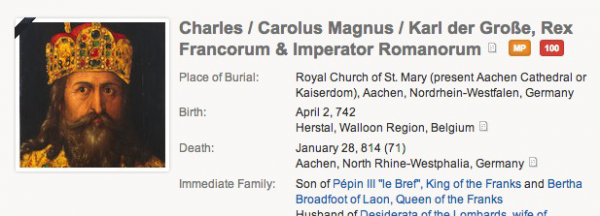New on Geni: Multilingual Profiles
Geni’s World Family Tree, now almost 80 million profiles strong, enables people of all nationalities and cultures to work together to discover their shared ancestry. One of the greatest challenges of creating a single family tree of the world is accommodating the many languages spoken by our international community. Today we’re excited to announce that Geni’s World Family Tree now supports multilingual profiles. This means you can enter names and biographies in multiple languages, and Geni will store them separately, and display them in your preferred language. No more confusion of tongues as in the biblical Tower of Babel!
Through the collaborative effort of millions of genealogists, our World Family Tree continues to grow every day. With branches extending all around the globe, we’ve seen more and more profiles where names and descriptions were being entered multiple times, in different languages, into a single set of fields. In today’s release, profiles have become multilingual and you can now enter profile names and biographies separately in any of the 75 languages that are actively used on Geni.
If a profile name exists in the language you’ve selected for Geni, you will see that name in your language. We’ve also designed a sophisticated fallback mechanism for choosing which name to display when a name is not available in your chosen language.
With these changes, a profile such as Charlemagne’s will look significantly better. Previously, if you wanted to enter Charlemagne’s name in multiple languages, you were forced to put them all in the same field, leaving the profile with a messy mix of names in various languages.
Charlemagne, before (English):
Now name fields can be entered and stored separately in any language for any profile using a clever system that uses fallbacks to display the best information available.
Charlemagne, after (English):
Charlemagne, after (German):
Charlemagne, after (Russian):
Furthermore, the ‘About Me’ (biography) sections of your Geni profiles now also support multiple languages. You can enjoy this rich content in your native language, without having to scroll through similar information in foreign languages.
Let’s take a closer look at how to use this new feature. First, you’ll notice we’ve designed a new form for adding profiles to your tree. This form not only supports multilingual names, but is also designed to help you build your tree as quickly and accurately as possible:
While most of the fields above should look familiar, there are some big improvements. The header reminds you who you’re adding, and you can click “Show current family members” to make sure you’re not adding a duplicate. After clicking the yellow arrows in the tree, the relationship and gender will be filled in automatically. The first name field is highlighted in blue so you can start typing without having to click first. The Save button is always visible at the bottom, so once you’ve entered all the information you have you can submit the form without having to scroll down to find it. And if you’ve got more family members to add, just turn on the “Add another family member…” checkbox and you’ll get a new form as soon as you click Save!
Most important, however, are the new multilingual name fields! English will remain the default language for names on Geni, however if a profile has a different name or character set in another language (e.g. Russian, Greek, Hebrew, etc.), you can add it easily by clicking the “Add Language…” button. Doing so will display a language selection dialog similar to how you choose your own language for the Geni interface:
You may have noticed already that the language subtypes are missing — an English name is English regardless of US or UK, similarly with Spanish, Portuguese, etc. If you’ve chosen to view Geni’s interface in a language that uses a non-Latin character set, that language will automatically be suggested for you as a tab labeled “Add <your language>”.
Tip: Names that are the same in English as in the profile’s native tongue, such as Pierre in French (same as Pierre in English) or Hans in German (same as Hans in English), should be entered as the English (default) name. There is no need to enter these identical names on multiple language tabs.
We’ve enhanced the edit profile dialog as well to support multiple languages:
Notice that we’ve also added a cool feature here: when you edit a name in a new language, it will show you how it has been entered in your language or English, below each field so you can quickly translate it. If a name has not yet been entered in your language or English, it will show you the name in the first available language.
How will I know if a profile has names in other languages?
Take a closer look at the Charlemagne example above. If you’re using Geni in German, you’ll see something like this to the right of the profile photo:
Note that the large-format name will be in your chosen language, if available, and names in other languages are listed below, in a smaller font. The “hover cards” you sometimes see when holding the mouse above a linked name have also been updated to show multilingual names, as well.
How does Geni display a profile that doesn’t have a name in my preferred language?
We’ve developed a fallback system for choosing which language name to show you. If a profile does not have a name in your chosen interface language, we’ll first check to see if there’s an English name. If so, that’s what you’ll see. Otherwise, we’ll choose the first available language to display. Certain name fields will be paired together as part of this selection process: we won’t mix first name and middle name from different languages, nor will we mix last name and maiden name from different languages. However, if a profile has a first or middle name in one language and a last or maiden name in another, we will combine these in order to show you as much information as possible.
How will I know if a profile has a biography in other languages?
If a profile has a biography in multiple languages, you will see a new language selector to the right of the About Me heading. Simply select the language in which to view the biography:
How do I search multilingual names?
Searching is automatic — whenever you use the “quick search” bar at the top of every Geni page, or the individual name fields on our advanced search form, Geni will match your query against all languages of all profiles. This applies to matching, too, so you may discover Tree Matches that match only in certain languages.
We’ve also updated our merge comparison interface to show you the multilingual details:
(click to zoom)
We have updated all of Geni’s functionality to take advantage of this new feature: searching, tree matching, family tree charts, data exports and more have all been enhanced to recognize multilingual names. And we are in the process of automatically parsing all existing, mixed-up name components to move them into language-specific fields wherever possible — we’re confident our enormous, active Geni community will help sort out the profiles where we were not able to do this automatically.
The World Family Tree has never looked better now that everyone can view their relatives’ profiles in their native language without the mess of other languages cluttering the same profile.
Here’s a nice example showing multilingual profiles in action.
Geni’s biblical tree before the enhancements:
(click to zoom)
After (English):
(click to zoom)
After (Hebrew):
(click to zoom)
After (Arabic):
(click to zoom)
Just like Wikipedia supports multiple languages, so now does Geni only in a rich, structured form – names and biographies can be provided in individual languages, while dates, relationships and other non-language-dependent information need only be entered once, and are automatically displayed in localized form.
We feel this is a significant step forward in globally collaborative genealogy. By enabling users to enter and view the names and biographies of their relatives’ profiles separately in multiple languages, without combining them into the same fields, our global community can now view the profiles in the tree with ease in the language of their own preference. As custodians of the World Family Tree, we believe this latest enhancement helps bring all of us closer to realizing the goal of building the definitive family tree of the world.
Check out your multilingual family tree now!






















 Genealogy Discussions
Genealogy Discussions Genealogy Projects
Genealogy Projects Popular Genealogy Profiles
Popular Genealogy Profiles Surnames
Surnames The Geni Blog
The Geni Blog The World Family Tree
The World Family Tree